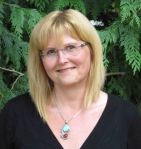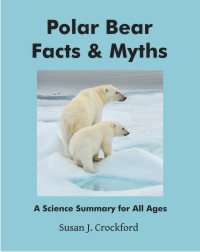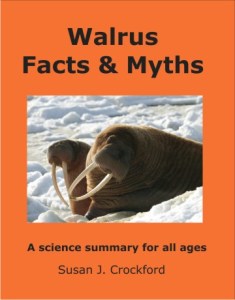Here you’ll find polar bear science without advocacy, fearmongering or spin. Most importantly, there will be no predictions about the future of polar bears!
My name is Susan Crockford and I am a zoologist with more than 35 40 years experience (at 2022), including published work on the Holocene history of Arctic animals. As of 1 July 2019, I am a former adjunct professor at the University of Victoria, British Columbia and work full time for a private consulting company I co-own with two colleagues, Pacific Identifications Inc.
Like Ian Stirling, grand-daddy of all polar bear biologists, I earned my undergraduate degree in zoology at the University of British Columbia. Polar bear evolution is one of my professional interests, which I discuss in my 2006 book, Rhythms of Life: Thyroid Hormone and the Origin of Species (based on my Ph.D. dissertation earned in 2004 at the University of Victoria, B.C. Canada). In other words, I am a professional zoologist with a Ph.D. [updated 8 June 2022].
You’ll find a list of my publications (with a brief introduction) further down, after the list of my most popular posts (with links). At the bottom of this page is a brief bio for posting elsewhere.
And as polar bear biologist Ian Stirling states in the introduction to his new book, the opinions expressed here are my own and do not necessarily reflect those of any of the agencies that have supported my research [and in my case, this includes the University of Victoria]. No one pays me to write this blog.
I am a different kind of polar bear expert than those that study bears in the field but having a different background means I know things they do not and this makes my contribution valuable and valid.
UPDATE: For more detail on my background and participation in polar bear science, see this 12 March 2015 post, “On being a polar bear expert, among other things” http://atomic-temporary-38650637.wpcomstaging.com/2015/03/12/on-being-a-polar-bear-expert-among-other-things/ [short link for twitter etc. http://wp.me/p2CaNn-c5y%5D
My most popular posts so far (to end December, 2013) have been these:
“Global population of polar bears has increased by 2650-5700 since 2001” (July 15, 2013)
…and a previous post on population assessments: “PBSG polar bear population assessment made simple” (Oct. 21. 2013)
“Ian Stirling’s latest howler: the polar bear who died of climate change” (Aug. 7, 2013)
…and its follow-up: “Ian Stirling’s howler update: contradicted by scientific data” (Aug. 11, 2013)
“Ten good reasons not to worry about polar bears” (Feb. 26, 2013)
…and its update: “Polar bears have not been harmed by sea ice declines in summer: the evidence” (Aug. 18, 2013)
“Signs that Davis Strait polar bears are at carrying capacity” (June 10, 2013)
“How and why great news about Chukchi polar bears has been suppressed” (Sept. 8, 2013)
…and its follow-up post: “Record sea ice loss in 2007 had no effect on polar bears, Chukchi study confirms” (Sept. 15, 2013)
One of my first and still popular: “The slaughter of polar bears that rarely gets mentioned” (Sept. 20, 2012)
Two of my personal favorites: “Where were the appeals to feed starving polar bears in 1974?” (Feb. 21 2013)
…and this follow-up post: “Great polar bear red herring in the Southern Beaufort” (July 4 2013)
My first post, explaining why I do this: “Cooling the polar bear spin” (July 26, 2012)
x-x-x-x-x-x-x-x-x-x-x-x-x-x-x-
Selected list of publications 1990-2022 [updated June 8, 2022]
The wide variety in my professional publications stem from my academic background as a zoologist (with a long-standing interest in evolution, including dog domestication) and the practical skill I learned early in my professional career – the ability to identify the broken and/or digested bones of a wide variety of animals (including fish, reptiles and amphibians, birds, terrestrial mammals and marine mammals).
It might be hard to imagine that these interests and skills not only intersect but include polar bears. However, they do. For example, the evolutionary transformation of brown bears to polar bears, and wolves to dogs, involved a similar biological process; bones of brown bears and polar bears, like the bones of wolves and dogs, are similar yet distinctive.
I’ve marked those papers that are especially pertinent to Arctic (**) and Subarctic (*) biology and paleoecology/glacial history [contact me if you would like copies, via the Comments/Tips page]
Polar bear and walrus reports, books, and papers
**Crockford, S.J. 2022a. Fallen Icon: Sir David Attenborough and the Walrus Deception. S.J. Crockford, Victoria. Hard cover, paperback, and ebook formats.
**Crockford, S.J. 2022b. The State of the Polar Bear 2021. Global Warming Policy Foundation Note 29, London. pdf here.
**Crockford, S.J. 2022c. Polar bear fossil and archaeological records from the Pleistocene and Holocene in relation to sea ice extent and open water polynyas. Open Quaternary 8(7): 1-26. https://doi.org.10.5334/oq.107
**Crockford, S.J. 2021a. The State of the Polar Bear Report 2020. Global Warming Policy Foundation Report 48, London.
**Crockford, S.J. 2021b. Walrus Facts and Myths. SJ Crockford, Victoria. Paperback and ebook formats.
**Crockford, S.J. 2020. State of the Polar Bear 2019. Global Warming Policy Foundation Report 39, London.
**Crockford, S.J. 2019a. State of the Polar Bear 2018. Global Warming Policy Foundation Report 32, London.
**Crockford, S.J. 2019b. The Polar Bear Catastrophe That Never Happened. Global Warming Policy Foundation, London. Paperback and ebook formats.
**Crockford, S.J. 2018. State of the Polar Bear Report 2017. Global Warming Policy Foundation Report #29. London. pdf here.
**Crockford, S.J. and Geist, V. 2018. Conservation Fiasco. Range Magazine, Winter 2017/2018, pg. 26-27. Pdf here.
**Crockford, S.J. 2017a. Testing the hypothesis that routine sea ice coverage of 3-5 mkm2 results in a greater than 30% decline in population size of polar bears (Ursus maritimus). PeerJ Preprints 2 March 2017. Doi: 10.7287/peerj.preprints.2737v3 Open access. https://doi.org/10.7287/peerj.preprints.2737v3
**Crockford, S.J. 2017b. Polar Bears: Outstanding Survivors of Climate Change. Amazon CreateSpace https://www.amazon.com/dp/1541139712
**Crockford, S.J. 2017c. Alaska polar bear subpopulations. pg. 12-23 in Arctic Alaska caribou herds and polar bear subpopulations (with M.A. Cronin). Report of Arctic Slope Regional Corporation, Anchorage, Alaska.
**Crockford, S.J. 2016a. Polar Bear Facts and Myths. Spotted Cow Presentations Inc., Victoria. Paperback and ebook formats.
**Crockford, S.J. 2015. The Arctic Fallacy: Sea Ice Stability and the Polar Bear. Global Warming Policy Foundation Briefing Paper 16. London. Available at http://www.thegwpf.org/susan-crockford-the-arctic-fallacy-2/
**Crockford, S. J. 2014. On the Beach: Walrus Haulouts are Nothing New. Global Warming Policy Foundation Briefing Paper 11. http://www.thegwpf.org/susan-crockford-on-the-beach-2/
**Crockford, S. J. 2012a. A History of Polar Bears, Ringed Seals, and other Arctic and North Pacific Marine Mammals over the Last 200,000 Years. A report prepared for the State of Alaska Department of Commerce, Community and Economic Development and The University of Alaska Fairbanks. Pacific Identifications Inc., Victoria, British Columbia.
**Crockford, S.J. 2012b. Directionality in polar bear hybridization. Comment (May 1) to Hailer et al. 2012. “Nuclear genomic sequences reveal that polar bears are an old and distinct bear lineage.” Science 336:344-347. Follow link and click on “# comments” under the title http://comments.sciencemag.org/content/10.1126/science.1216424
**Crockford, S.J. 2012c. Directionality in polar bear hybridization. Comment, with references (May 1) to Edwards et al. 2011. “Ancient hybridization and an Irish origin for the modern polar bear matriline.” Current Biology 21:1251-1258. to view comments, go through the host website, http://www.Cell.com and find the paper at the Current Biology website. http://www.cell.com/current-biology/abstract/S0960-9822%2811%2900645-2#Comments
Zoogeography, paleoecology, archaeozoology and ostemetry papers
Crockford, S. 2016b. Prehistoric mountain goat Oreamnos americanus mother lode near Prince Rupert, British Columbia and implications for the manufacture of high-status ceremonial goods. Journal of Island and Coastal Archaeology. https://doi.org/10.1080/15564894.2016.1256357
**Crockford, S. J. 2012d. Annotated map of ancient polar bear remains of the world. Electronic resource, available at http://polarbearscience/references ISBN 978-0-9917966-0-1. http://atomic-temporary-38650637.wpcomstaging.com/2012/11/26/ancient-polar-bear-remains-of-the-world/
*Crockford, S.J. 2012e. Archaeozoology of Adak Island: 6000 years of subsistence history in the central Aleutians. Pg. 109-145 in D. West, V. Hatfield, E. Wilmerding, L. Gualtieri and C. Lefevre (eds), The People Before: The Geology, Paleoecology and Archaeology of Adak Island, Alaska. British Archaeological Reports International Series, Oxford, pg 109-145. ISBN 978-4073-0905-7
*Nishida, S., West, D., Crockford, S. and Koike, H. 2012. Ancient DNA analysis for the sea otter (Enhydra lutris) from archaeological sites on Adak, Aleutian Islands. Pg. 147-165 in D. West, V. Hatfield, E. Wilmerding, C. Lefèvre, L. Gualtieri (eds.), The People Before: The Geology, Paleoecology and Archaeology of Adak Island, Alaska. Oxford, British Archaeological Reports, International Series 2322, ISBN 978-4073-0905-7.
*Wilson, B.J., Crockford, S.J., Johnson, J.W., Malhi, R.S. and B.M. Kemp. 2011. Genetic and archaeological evidence for a former breeding population of Aleutian Cackling Goose (Branta hutchinsii leucopareia) on Adak Island, central Aleutians, Alaska. Canadian Journal of Zoology 89: 732-743. http://www.nrcresearchpress.com/journal/cjz
**Crockford, S.J. and G. Frederick 2011. Neoglacial sea ice and life history flexibility in ringed and fur seals. pg.65-91 in T. Braje and R. Torrey, eds. Human Impacts on Seals, Sea Lions, and Sea Otters: Integrating Archaeology and Ecology in the Northeast Pacific. U. California Press, LA.
*Baichtal, J.F. and Crockford, S.J. 2011. Possibility of kelp during the LGM in SE Alaska and implications for marine mammals. Poster 5-12, 19th Conference on the Biology of Marine Mammals, Tampa, FL. Nov. 28-Dec.2.
**Crockford, S.J. 2008. Be careful what you ask for: archaeozoological evidence of mid-Holocene climate change in the Bering Sea and implications for the origins of Arctic Thule. Pp. 113-131 in G. Clark, F. Leach and S. O’Connor (eds.), Islands of Inquiry: Colonisation, Seafaring and the Archaeology of Maritime Landscapes. Terra Australis 29 ANU E Press, Canberra. http://epress.anu.edu.au/ta29_citation.html
**Crockford, S. and Frederick, G. 2007. Sea ice expansion in the Bering Sea during the Neoglacial: evidence from archaeozoology. The Holocene 17(6):699-706.
*Crockford, S.J., Frederick, G. & Wigen, R. 2002. The Cape Flattery fur seal: An extinct species of Callorhinus in the eastern north Pacific? Canadian Journal of Archaeology 26(3):152-174. http://www.canadianarchaeology.com/publications.lasso
Martinsson-Wallin, H. & Crockford, S.J. 2001. Early human settlement of Rapa Nui (Easter Island). Asian Perspectives 40(2):244-278. (Includes an analysis of fish remains & a comprehensive list of modern Rapa Nui fishes). http://muse.jhu.edu/journals/asi/
Crockford, S.J. 1997. Archaeological evidence of large northern bluefin tuna, Thunnus thynnus, in coastal waters of British Columbia and northern Washington. Fishery Bulletin 95:11-24. http://fishbull.noaa.gov/
Domestication, speciation and evolution papers
Crockford, S.J. and Kusmin, Y.V. 2012. Comments on Germonpré et al., Journal of Archaeological Science 36, 2009 “Fossil dogs and wolves from Palaeolithic sites in Belgium, the Ukraine and Russia: osteometry, ancient DNA and stable isotopes”, and Germonpré, Lázkičková-Galetová, and Sablin, Journal of Archaeological Science 39, 2012 “Palaeolithic dog skulls at the Gravettian Předmostí site, the Czech Republic.” Journal of Archaeological Science 39:2797-2801. http://www.sciencedirect.com/science/article/pii/S0305440312001537
Ovodov, N.D., Crockford, S.J., Kuzmin, Y.V., Higham, T.F.G., Hodgins, G.W.L. and van der Plicht, J.. 2011. A 33,000 year old incipient dog from the Altai Mountains of Siberia: Evidence of the earliest domestication disrupted by the Last Glacial Maximum. PLoS One 10.1371/journal.pone.0022821. http://www.plosone.org/article/info%3Adoi%2F10.1371%2Fjournal.pone.0022821
Crockford, S.J. 2009. Evolutionary roots of iodine and thyroid hormones in cell-cell signaling. Integrative and Comparative Biology 49:155-166.
**Crockford, S.J. 2006. Rhythms of Life: Thyroid Hormone and the Origin of Species. Trafford, Victoria [for a general audience, polar bear evolution discussed];
**Crockford, S.J. 2004. Animal Domestication and Vertebrate Speciation: A Paradigm for the Origin of Species. Ph.D. dissertation, University of Victoria (Canada), Interdisciplinary Studies. [filed at the National Library under Zoology; polar bear evolution discussed] Pdf available, just ask.
**Crockford, S.J. 2003. Thyroid rhythm phenotypes and hominid evolution: a new paradigm implicates pulsatile hormone secretion in speciation and adaptation changes. International Journal of Comparative Biochemistry and Physiology, Part A Vol. 35 (#1, May issue):105-129. http://www.elsevier.com/ [an invited submission; polar bear evolution discussed]
**Crockford, S.J. 2002. Thyroid hormone in Neandertal evolution: A natural or pathological role? Geographical Review 92(1):73-88. http://www.jstor.org/journals/00167428.html [an invited commentary]
**Crockford, S.J. 2002. Animal domestication and heterochronic speciation: the role of thyroid hormone. pg. 122-153. In: N. Minugh-Purvis & K. McNamara (eds.) Human Evolution Through Developmental Change. Johns Hopkins University Press, Baltimore. http://www.press.jhu.edu/press/books/index.htm [polar bear evolution discussed].
Crockford, S.J. 2000. Dog evolution: a role for thyroid hormone in domestication changes. pg. 11-20. In: S. Crockford (ed.), Dogs Through Time: An Archaeological Perspective. Archaeopress S889, Oxford. http://www.archaeopress.com/defaultBar.asp
Crockford, S. J. 2000. A commentary on dog evolution: regional variation, breed development and hybridization with wolves. pg. 295-312. In: S. Crockford (ed.), Dogs Through Time: An Archaeological Perspective. Archaeopress S889, Oxford. http://www.archaeopress.com/defaultBar.asp
Northwest Coast dog studies
Crockford, S.J. 1997. Osteometry of Makah and Coast Salish Dogs. Archaeology Press, Publication 22, Simon Fraser University, Burnaby, B.C. http://www.sfu.ca/archaeology/dept/arcpress/index.htm[A comprehensive analysis of cranial & postcranial remains of adult dogs from 20 coastal archaeological sites]
Crockford, S.J., 2005. Breeds of native dogs in North America before the arrival of European dogs. Proceedings of the World Small Animal Veterinary Congress, Mexico City. [invited lecture] available online at: http://www.vin.com/proceedings/Proceedings.plx?CID=WSAVA2005&PID=11071&O=Generic
Crockford, S.J. and Pye, C.J. 1997. Forensic reconstruction of prehistoric dogs from the Northwest Coast. Canadian Journal of Archaeology 21(2):149-153 [the story of the wool dog/village dog sketches done by RCMP forensic artist CJ Pye] http://www.canadianarchaeology.com/publications.lasso
Crockford, S.J., Moss, M.L., and Baichtal, J.F. 2012. Pre-contact dogs from the Prince of Wales archipelago, Alaska. Alaska Journal of Anthropology 9(1):49-64.
Koop, B.F., Burbidge, M., Byun, A., Rink, U, & Crockford, S.J. 2000. Ancient DNA evidence of a separate origin for North American indigenous dogs. pg. 271-285. In: S. Crockford (ed.), Dogs Through Time: An Archaeological Perspective. British Archaeological Reports (B.A.R.), Archaeopress S889, Oxford. http://www.archaeopress.com/defaultBar.asp (collaborative research with Univ. of Victoria (Ben Koop, Biology) & National Science & Engineering Research Council, Canada (NSERC) [first published analysis of ancient dog DNA]
Leathlobhair, M.N., Perri, A.R., Irving-Pease, E.K., et al. [including Crockford, S.J.]. 2018. The evolutionary history of dogs in the Americas. Science 361:81–85.
McKechnie, I., Moss, M.L. and Crockford, S.J. 2020. Domestic dogs and wild canids on the Northwest Coast of North America: animal husbandry in a region without agriculture? Journal of Anthropological Archaeology 60:101209.
Seal and sea lion diet studies
Tollit, D.J., Schulze, A., Trites, A.W., Olesiuk, P., Crockford, S.J., Gelatt, T., Ream, R. & Miller, K. 2009. Development and application of DNA techniques for validating and improving pinniped diet estimates based on conventional scat analysis. Ecological Applications 19(4):889-905. [This study compares my bone ID of prey species to DNA analysis] http://www.esajournals.org/doi/abs/10.1890/07-1701.1
Olesiuk, P.F., Bigg, M.A., Ellis, G.M., Crockford, S.J. & Wigen, R.J. 1990. An assessment of the feeding habits of harbour seals (Phoca vitulina) in the Strait of Georgia, British Columbia, based on scat analysis. Canadian Technical Reports on Fisheries & Aquatic Science. 1730.
http://pubs.nrc-cnrc.gc.ca/cgi-bin/rp/rp2_tocs_e?cjfas_cjfasS1-98_55
x-x-x-x-x-x-x-x-x-x-x-x-x-x-x-x-x-x-x-
A BRIEF BIO FOR POSTING ELSEWHERE [updated 8 June 2022]:
Dr. Susan J. Crockford is a professional zoologist with a Ph.D. and more than 40 years experience, including work on the Holocene history of Arctic animals. Like polar bear biologist Ian Stirling, Susan Crockford earned her undergraduate degree in zoology at the University of British Columbia. She was an adjunct professor at the University of Victoria, B.C. for 15 years (2004-2015). Polar bear evolution is one of Dr. Crockford’s professional interests, which she discusses in her 2006 book, Rhythms of Life: Thyroid Hormone and the Origin of Species. She writes a science blog about polar bears at PolarBearScience.com and descriptions of her books can be found at https://susancrockford.com
A list of selected publications and favorite posts are available above.






You must be logged in to post a comment.